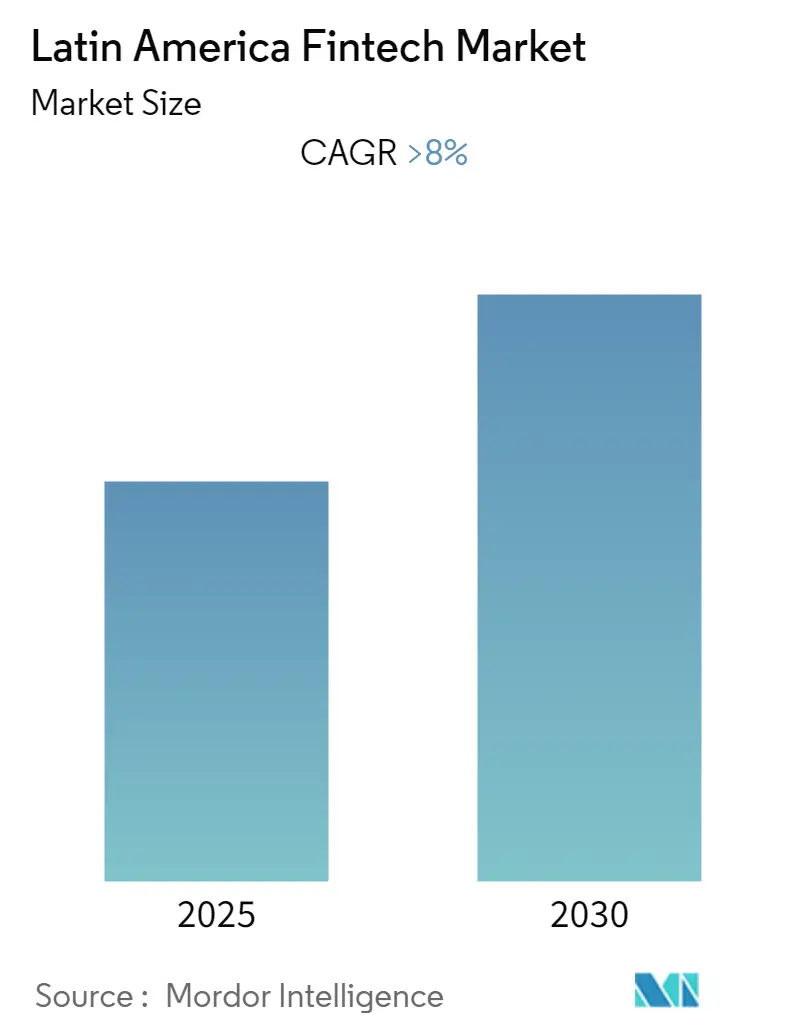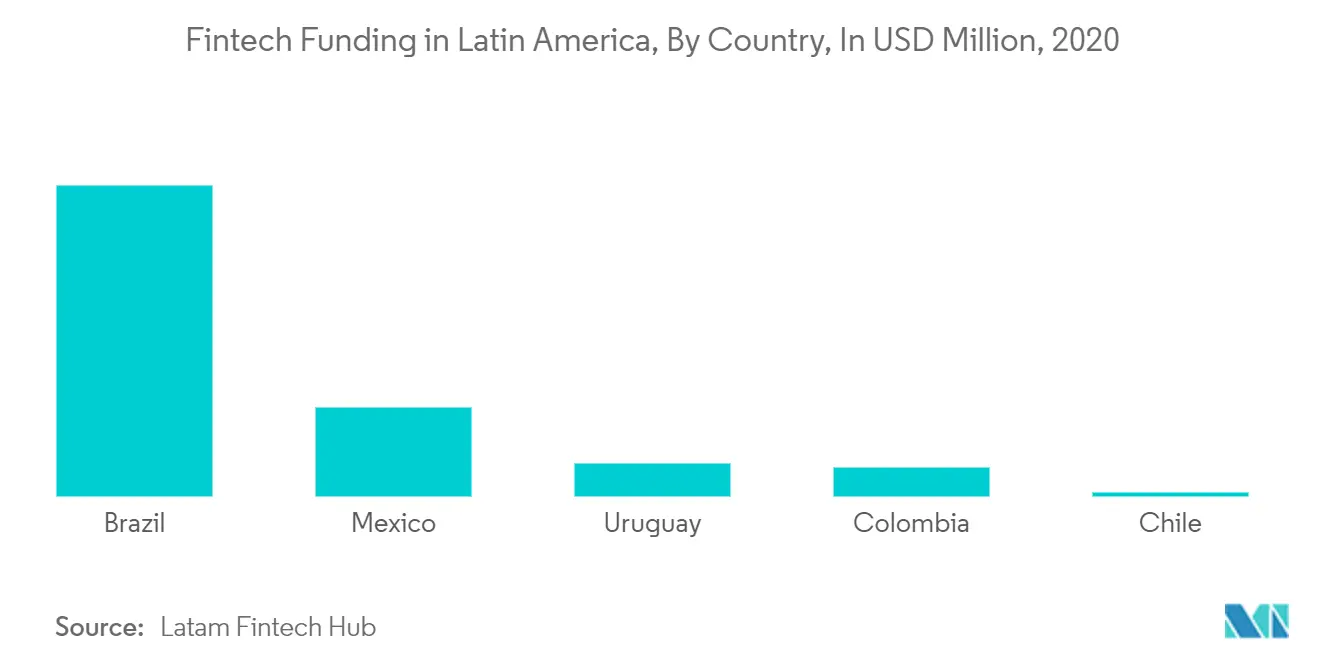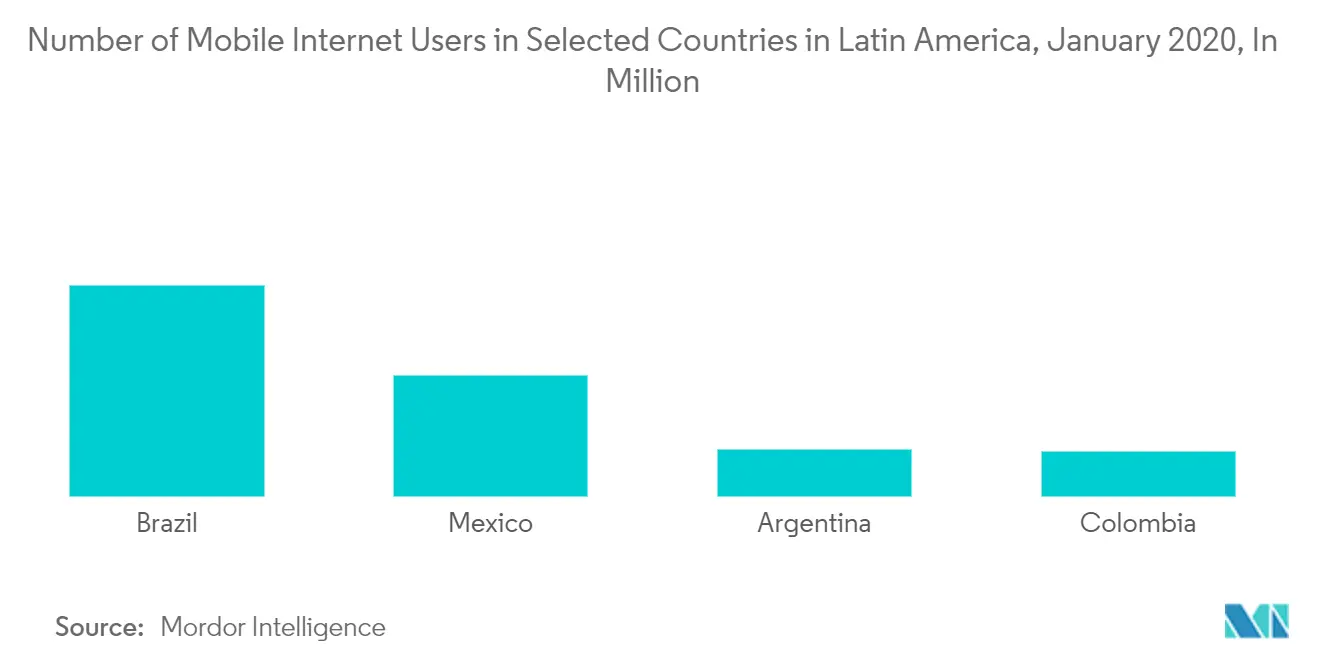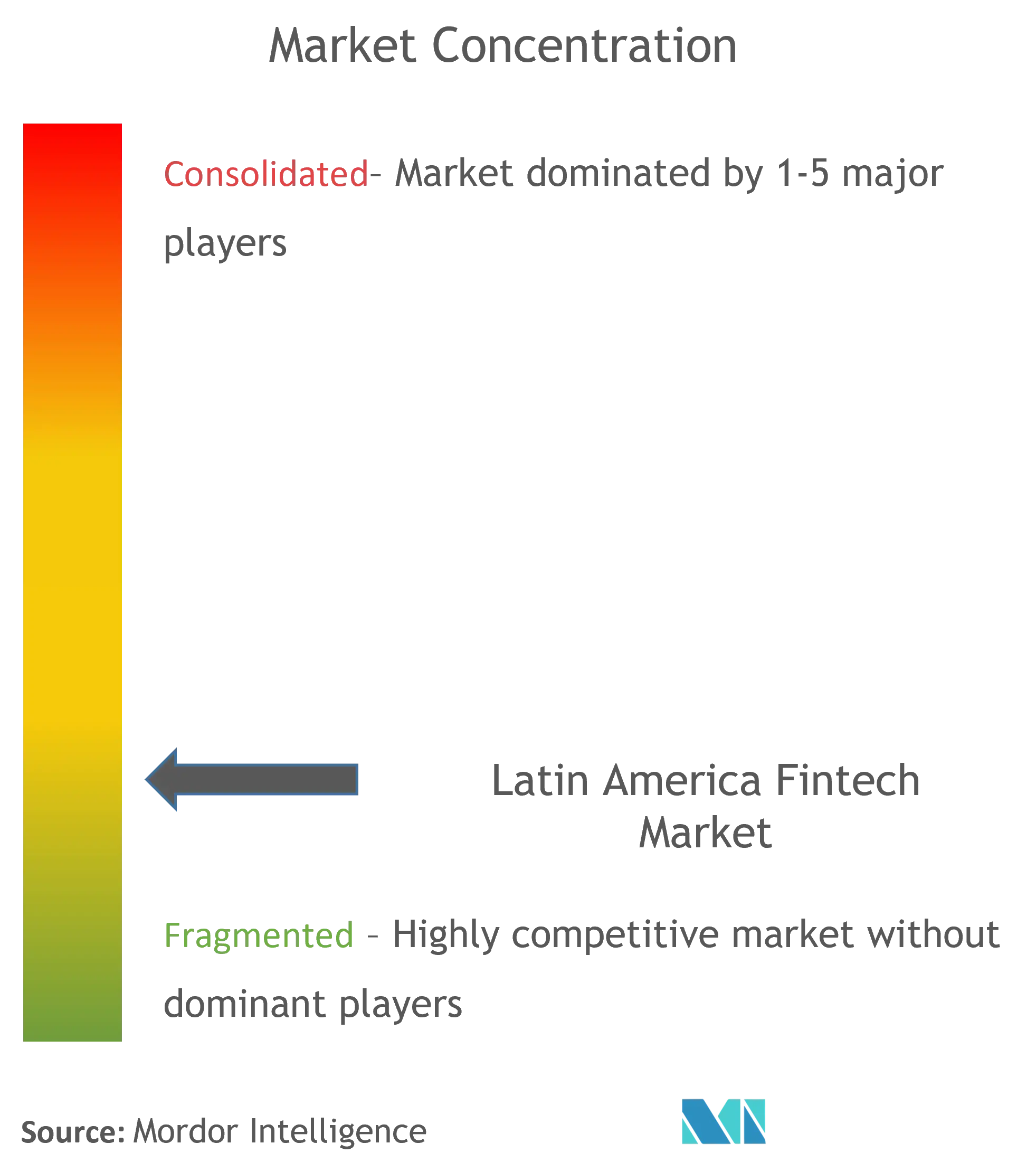
Latin America Fintech Market Analysis by Mordor Intelligence
The Latin America Fintech Market is expected to register a CAGR of greater than 8% during the forecast period.
The epidemic has had a significant influence on global financial services. However, in Latin America, the COVID -19 crisis has been a major engine for fintech, pushing innovation out of necessity. Instead of visiting physical bank branches, many consumers checked out innovative financial products and apps. Many businesses that used to rely on foot traffic have begun to provide online shopping, accept credit card payments, and integrate with digital platforms. COVID - 19 has boosted demand for digital financial products and fintech in Latin America.
Fintech activity is expanding in the region, spurred by rising demand for online banking solutions, favourable demographics, and a substantial underserved population. From USD 44 million in 2013, FinTech funding has increased to USD 2.1 billion in 2019. In the first half of 2020, Latin American Fintech raised approximately USD 525 million. Around 1166 FinTech start-ups were identified in the 18 countries of the Latin America region in the year 2018. There was an increase of 66% from the last year when the number was only 703.
According to the investment bank Goldman Sachs, the sector of payments, loans, personal finance, and insurance have the greatest potential. Goldman Sachs and Morgan Stanley, another major investment bank, invested in Brazilian Fintech startups to secure higher profit margins. In the middle of 2020, North and South Americas accounted for the largest share of total Fintech investments (USD 12.9 billion) while the Asia Pacific region and the EMEA accounted for USD 8.1 billion and USD 4.6 billion accordingly.
At last count, at least 1,166 fintech initiatives were operating, spread across 18 countries. In 2019 alone, VC investment in FinTech startups in Latin America totalled USD 2.1 billion. That number represented a growth of 690% over the past five years.
Latin America Fintech Market Trends and Insights
Brazil and Mexico, are Dominating the Market
Brazil, by far Latin America's most populous country, has a close to 70% internet penetration rate, compared to around 87% in Western Europe and the United States. With over 750 companies, Brazil is the largest fintech market. With 440 companies operating, Mexico has the second largest and most established financial ecosystem in Latin America.
The introduction of the regulatory sandbox, open banking regulations, and the launch of Pix, Brazil's rapid payment system, have all contributed to the growth of the indigenous fintech sector. A breakdown of fintech investment in the region reveals that investors are particularly optimistic about the prospects of the Brazilian industry, with statistics from Colombian platform Latin America Fintech Hub revealing that Brazilian companies received more than 66% of fintech funding in 2020.
According to Bruno Diniz, managing partner of fintech-focused consultancy Spiralem and one of Brazil's most important fintech specialists, more innovation and developments are predicted in the future, particularly in the fields of insurtech and open banking. Several significant, established Brazilian fintech companies are expected to go public in 2021.
With the enactment of the Fintech Law in 2018, Mexico became the first Latin American country to establish a dedicated fintech legal framework. The legislation governs two categories of fintech: crowdfunding institutions and electronic money and payment institutions, as well as for cryptocurrencies, open banking, and a regulatory sandbox.
According to data from the National Banking and Securities Commission, 93 fintech companies were in the process of gaining a Financial Technology Institution (FTI) license as of early 2021, indicating substantial interest from the startup community.
Mexico, like Brazil and other emerging economies, has a significant young and tech-savvy population that is underserved by traditional banking and financial services and willing to adopt new, digital-first financial products and services. The favourable regulatory environment and good demographics have created a great basis for fintech startups to prosper.

Massive Technological Adaption is Boosting the Market
Latin America is home to a population of roughly 450 million mobile phone users, which is expected to reach 484 million by 2025. Of these 450 million users, nearly 80% access the internet via their phone - a proportion that is forecasted to reach 87% by 2025. Better telecommunication infrastructures and increasing internet access will be responsible for driving step-function growth across the entire region for fintech. These massive technological shifts have been a boon for fintech startups to build fully digital products and services and pass cost savings through to customers.
Banking regulators and central banks in the region are bending over backwards to embrace new financial technologies. Internet availability has increased upward mobility and increased access to international high-level degree programs. Both factors have created a rising, highly educated middle class that has become the founders of many of the regional FinTech startups.
An increase in the number of mobile phone users also means that there will be an increase in mobile payment options too. For an instance, QR code payments are slowly gaining popularity in the Latin American region. The scenario of rising e-invoicing is interesting because despite Latin America being behind in the digital payment rates, it is emerging as a global leader in e-invoicing. This signifies that the region is experiencing a FinTech boom, and it will cause a trickle-down effect that will encourage people to adopt digital payments fully.
Brazil contributes around 42% when it comes to Latin America's B2C retail transactions. Furthermore, the retail scene is expected to grow by around 39%. Mobile wallets enable users to make automated purchases. Digital payments are on the verge of a boom in the Latin American region due to the rise of neo-banks, e-wallets, e-invoicing, etc. The increased demand for digital payments from both consumers and businesses is boosting the growth and adoption of digital payment solutions.

Competitive Landscape
Central banks in Latin America have done everything they can to push businesses and consumers away from cash and toward digital payment solutions, frequently leading them directly into the clutches of FinTech companies. Some of the major players in the market are Nubank, Uala, Ebanx, RecargaPay, Clip, Bitso, Konfio, Wilobank, Addi, Vortx and others.
Latin America Fintech Industry Leaders
Nubank
Ebanx
Wilobank
Vortx
Bitso
- *Disclaimer: Major Players sorted in no particular order

Recent Industry Developments
July 2021 - Z1, a digital bank geared at Latin American GenZers based in Sao Paulo, has secured USD 2.5 million in a round led by Homebrew in the United States. Z1 is a digital banking software designed specifically for teenagers and young people. The company was formed on the idea that Brazilian and Latin American teenagers may become more financially independent by using its app and linked prepaid card. Z1 is focused on Brazil but the startup has plans to expand into other countries in Latin America over time.
June 2021 - Conductor, a leading payments & banking as service platform in Latin America, has announced the arrival of its technological platform in Mexico, considered strategic for the internationalization and global expansion of the company.
Latin America Fintech Market Report Scope
The report on the Latin America Fintech market provides a comprehensive evaluation of the market with market segmentation, product categories, existing market trends, market dynamics shifts, and growth opportunities. The market is segmented by Service Proposition (Money Transfer and Payments, Savings and Investments, Digital Lending & Lending Marketplaces, Online Insurance & Insurance Marketplaces, and Others), and by Country (Brazil, Mexico, Argentina, and Rest of Latin America).
| Money Transfer and Payments |
| Savings and Investments |
| Digital Lending & Lending Marketplaces |
| Online Insurance & Insurance Marketplaces |
| Others |
| Brazil |
| Mexico |
| Argentina |
| Rest of Latin America |
| By Service Proposition | Money Transfer and Payments |
| Savings and Investments | |
| Digital Lending & Lending Marketplaces | |
| Online Insurance & Insurance Marketplaces | |
| Others | |
| By Country | Brazil |
| Mexico | |
| Argentina | |
| Rest of Latin America |
Key Questions Answered in the Report
What is the current Latin America Fintech Market size?
The Latin America Fintech Market is projected to register a CAGR of greater than 8% during the forecast period (2025-2030)
Who are the key players in Latin America Fintech Market?
Nubank, Ebanx, Wilobank, Vortx and Bitso are the major companies operating in the Latin America Fintech Market.
What years does this Latin America Fintech Market cover?
The report covers the Latin America Fintech Market historical market size for years: 2020, 2021, 2022, 2023 and 2024. The report also forecasts the Latin America Fintech Market size for years: 2025, 2026, 2027, 2028, 2029 and 2030.
Page last updated on:
Latin America Fintech Market Report
Latin America Fintech Market is witnessing remarkable growth, propelled by digital payments, big data, investments, and alternative finance innovations. The surge in fintech startups, particularly in Latin America, is supported by high internet and mobile device adoption, alongside regulatory efforts to enhance financial inclusion and dismantle traditional banking monopolies. This environment fosters easier market entry for new tech players. Blockchain technology is increasingly crucial, offering enhanced security and efficiency. The fintech market in Latin America is seeing a rise in service adoption among SMEs, benefiting from banking, payments, and financial management solutions. Market growth is further driven by big tech companies venturing into financial services, introducing innovative payment solutions. However, concerns over consumer data security pose challenges. The Latin America fintech market is segmented by technology, service, application, and deployment mode, with AI and payment services emerging as key areas. This dynamic market landscape presents numerous opportunities for fintech in Latin America, catering to a diverse range of financial needs and contributing to the sector's expansion. Get a sample of this industry analysis as a free report PDF download.
.webp)


